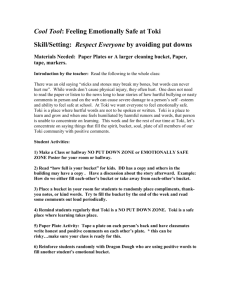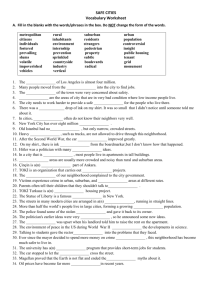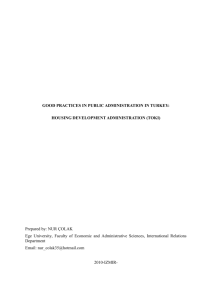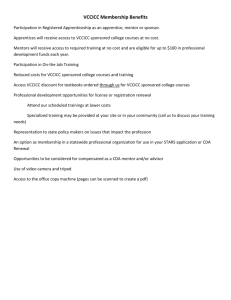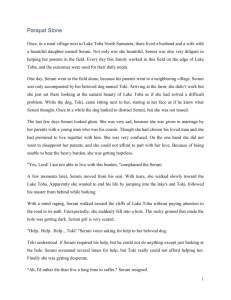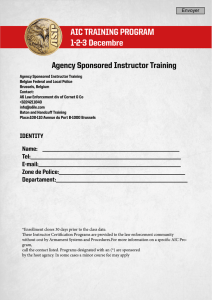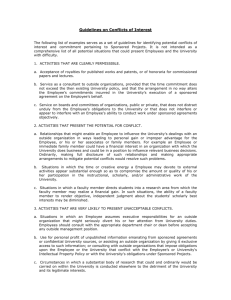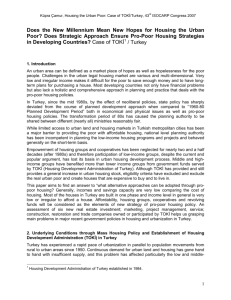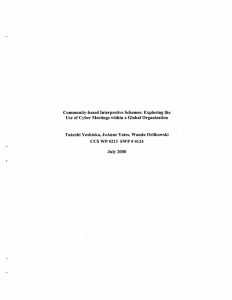Report - Urban Revitalization of Mass Housing
advertisement
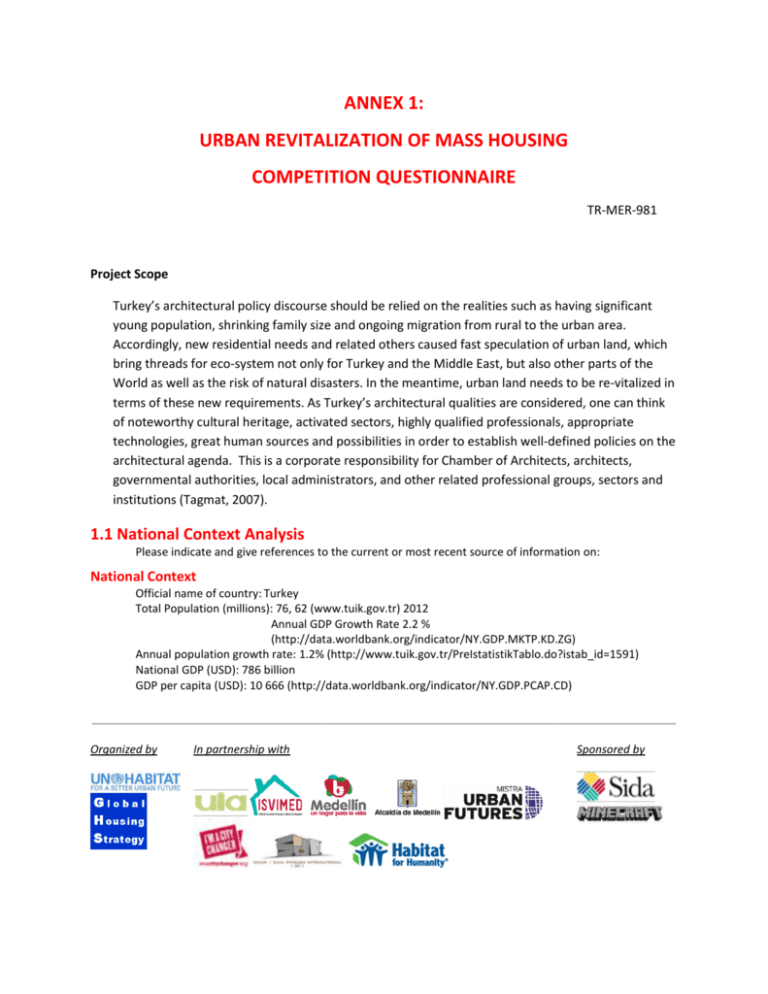
ANNEX 1: URBAN REVITALIZATION OF MASS HOUSING COMPETITION QUESTIONNAIRE TR-MER-981 Project Scope Turkey’s architectural policy discourse should be relied on the realities such as having significant young population, shrinking family size and ongoing migration from rural to the urban area. Accordingly, new residential needs and related others caused fast speculation of urban land, which bring threads for eco-system not only for Turkey and the Middle East, but also other parts of the World as well as the risk of natural disasters. In the meantime, urban land needs to be re-vitalized in terms of these new requirements. As Turkey’s architectural qualities are considered, one can think of noteworthy cultural heritage, activated sectors, highly qualified professionals, appropriate technologies, great human sources and possibilities in order to establish well-defined policies on the architectural agenda. This is a corporate responsibility for Chamber of Architects, architects, governmental authorities, local administrators, and other related professional groups, sectors and institutions (Tagmat, 2007). 1.1 National Context Analysis Please indicate and give references to the current or most recent source of information on: National Context Official name of country: Turkey Total Population (millions): 76, 62 (www.tuik.gov.tr) 2012 Annual GDP Growth Rate 2.2 % (http://data.worldbank.org/indicator/NY.GDP.MKTP.KD.ZG) Annual population growth rate: 1.2% (http://www.tuik.gov.tr/PreIstatistikTablo.do?istab_id=1591) National GDP (USD): 786 billion GDP per capita (USD): 10 666 (http://data.worldbank.org/indicator/NY.GDP.PCAP.CD) _____________________________________________________________________________________ Organized by In partnership with Sponsored by Urbanisation o Does your country have an officially adopted National Urban Policy? If so, please attach the PDF or provide the internet link. Yes. The ministry of environment and urban policies rely on the principles such as. "Urbanization process, cities more competitive , liveable and sustainable have the quality to be managed development of our country to achieve their goals important will contribute" (the 10th Development Plan, 2013:13), as well as spatial development strategy of the plan is a crucial pillar is: "Plan period, urban development Strategy and significant steps were taken to put into effect. Regulatory amendments made by the Environment and the Ministry of Urbanism upper scale spatial strategy plans with the construction mandated every kind and scale in the physical preparation of the plans and for implementing the basic principles, strategies and standards to identify and ensure the implementation is mandated to this at the provincial level to metropolitan municipalities are given the task of preparing the environmental plan (the 10th Development Plan, 2013:145). TOKİ -Housing Development Administration of Turkey- has seven affiliates. Two of them are real estate investment trusts (REITs). The others are offering variety of services including project management, real estate marketing, contracting, management services, real estate valuation, appraisal services, funding for restoration, trading and consultancy. (http://www.toki.gov.tr/english/affiliates.asp) o Does your country have an officially adopted Land Act or Land Code that determines land use? If so, please attach the PDF or provide the internet link. http://www.csb.gov.tr/turkce/index.php?Sayfa=mevzuat o Urban Population: absolute number: 75.627 th % of total population: % 72.3 (the 10 development plan, 2013: 219) o Slum Population TOKİ meets 5-10% of the housing needs of Turkey. According to Turkstat data, the total number of buildings throughout Turkey is 19 million 209 thousand 928 (approximately 20 million) and 40 percent of these buildings are shanty, and 67 percent lack settlement permit. Renovation, that is, demolition and rebuilding of approximately 6.5 million of the housing stock is necessary. The housing stock of our country amounting to 14 million requires handling whereby 6.5 million will be demolished and rebuilt within an average period of 20 years against disaster risk (http://www.toki.gov.tr/english/affiliates.asp). According to Urban slum population, percentages are distributed in the countries in Asia and the Pacific regions, seen below in the table for the year 2005. www.unescap.org/stat/data/syb2011/I-People/Urbanization.asp (11.01.2014) _____________________________________________________________________________________ Organized by In partnership with Sponsored by Depend on this table, slum population rate has been decrease since 2005. Recently, Absolute number is 10.6 million people, and % of total urban population: % 14.1 (the 10th Development Plan, 2013:145). o o o Annual urban population growth rate (%) : 18 % Annual slum population growth rate (%) : apprx. % 40 defined as shanty settlement or squatter housing (in Turkish ‘gecekondu’). Slums definition is not exactly equal to these, which are defined as above and these are not known as exact calculations and needed further research. 1 Overall number of vacant housing units % 7.5 http://www.clrsearch.com/Turkey-Demographics/NC/Housing-Statistics-Occupancy-and-Year-Built, download date: 11.01.2014 Formal Housing Legislation and regulations o Which national institution (ministry, department etc.) is responsible for housing policy? T. C. MINISTRY OF ENVIRONMENT AND PLANNING o Does your country have an officially adopted Housing Policy? If so, please attach the PDF or provide the internet link. 1 Vacant Housing Unit: A housing unit which is empty, not in use or unoccupied by tenants. It could be owned but not occupied or built by developers (public or private) but not handed over or sold to a resident. _____________________________________________________________________________________ Organized by In partnership with Sponsored by o The Housing Development Administration Of Turkey (TOKI) Has Direct Links To The Prime Minister. New added framework for Housing Strategy Development has launched. "KENTGES- Integrated Urban Development Strategy and Action Plan- (2010-2023)" Supreme Planning Board dated 25.10.2010 and 2010/34 have been accepted by the decision and November 4, 2010 and it was published in the Official Gazette numbered 27749. KENTGES; urbanization and development issues is a road map for central and local government. KENTGES Urban Development Strategy Document, transportation, infrastructure, housing and land delivery, disaster preparedness, protection, climate change, quality of life, social policy and participation issues at central and local level work to be done and the process is determined. www.kentges.gov.tr o Does your country have a National Building Code? 2012, Transformation of Disaster Risk Areas -Legislation Number: 6306 2006, Settlement Act-Legislation Number: 5543 1985, Building Code / Zonning Law, Legislation Number: 3194 1984, Mass Housing Ac , Legislation Number: 29421983, 1983, Environment Act, Legislation Number: 2872 1983, Expropriation Code , Legislation Number: 2942 1966, Gecekondu Law , Legislation Number: 775 1924, Land Reform, Legislation Number: 442 (www.csb.gov.tr All documentation taken from the official link of Turkish Republic’s Ministry of Environment and Planning in Turkish briefly translated) (www.csb.gov.tr All documentation taken from the official link of Turkish Republic’s Ministry of Environment and Planning in Turkish briefly translated) Housing supply and demand o Total number of existing housing units: According to Turkstat data, the total number of buildings throughout Turkey is 19 million 209 thousand 928 (approximately 20 million) and 40 percent of these buildings are shanty, and 67 percent lack settlement permit. Renovation, that is, demolition and rebuilding of approximately 6.5 million of the housing stock is necessary.(http://www.toki.gov.tr/english/HousingPrograms.asp, download date: 11.01.2014) o Annual supply of housing: 701 621 (2012) o How many units are provided annually by the following: There is no any officially information about amount of public sector, private sector, cooperatives and other(s).But TOKİ has public private partnership model. _____________________________________________________________________________________ Organized by In partnership with Sponsored by o o o Breakdown of housing types: [it is prepared by the Ministry of Environment and Urbanization within the framework of the necessity of renovation of the 15 million housing stock, whereby approximately 6.5 million houses are to be demolished and reconstructed within an average of 20 years against the disaster risk in our country, has also imposed significant tasks on TOKI.( http://www.toki.gov.tr/english/index.asp, download date: 11.01.2014)] Ownership: absolute number; % of total population : 67.33 (http://www.tuik.gov.tr/ilGostergeleri/iller/MERSIN.pdf s.56; downloading date: 11.01.2014) Rental: absolute number; % of total population (There is no any officially information about amount of rented house and population of settlement in rented house) Cooperative: absolute number; % of total population: There is no model of cooperative system after development of TOKİ. So there is no information. Condominium: absolute number; % of total population: Private housing sector base on the model of condominium. But there is no information about user. Other(s), please specify: absolute number; % of total population. None. Total number of unmet demand on housing according to TOKİ’s website data, “TOKİ meets 5-10% of the housing needs of Turkey. Renovation, that is, demolition and rebuilding of approximately 6.5 million of the housing stock is necessary. The housing stock of our country amounting to 14 million requires handling whereby 6.5 million will be demolished and rebuilt within an average period of 20 years against disaster risk.”( http://www.toki.gov.tr/english/HousingPrograms.asp) Average waiting period: According to TOKİ wensi“Since the property right is owned by TOKİ until the debt is over, the repayments of the projects are under guarantee. That is; TOKİ is acting as a ‘guarantor’ for the repayments of the project. TOKİ finalizes the construction of housing units within 14 - 24 months” (http://www.toki.gov.tr/english/HousingPrograms.asp). The private sector firms have finished faster than TOKİ such as a year. Housing finance o Kindly describe the housing finance system in your country on the following: TOKİ is a monopoly in house producer. According to TOKİ website data, “Social housing program of TOKİ targets the low and middleincome people who cannot own a housing unit under the existing market conditions. (Considering the distribution of the housing projects realized by TOKİ, 15% of the same consists of “Fund Raising by method of Revenue Sharing”, and 85% of “Social Housing” projects.) The beneficiaries of TOKİ’s social type housing projects (constructed on TOKİ-owned lands) make their down-payments at the beginning of construction (no down-payments for the poor groups’ projects) and then they continue to pay monthly due to a singleindex repayment plan. For most of these projects this index is the public sector wage index.( announced by the Ministry of Finance). For the projects targeting the poor citizens, monthly installments are increased (twice in a year) depending on the rate of increase for public sector wage index or Producer Price Index or Consumer Price Index (inflation indices announced by the Turkish Statistical Institution), whichever is smaller (namely; variable single-indexed credit system). The maturities of the loan repayments of TOKİ are set as 10 -15 -20 years in average depending on the financial capabilities of the target groups. 39.71 % of the social housing projects realized consists of those for the narrow- and middle-income groups. As to the _____________________________________________________________________________________ Organized by In partnership with Sponsored by 25.40 % portion of the projects, they consist of projects toward the low-income group and the poor. The urban transformation projects, which have recently become increasingly significant, have a ratio of 12.40 %. The Administration, taking into consideration the fact that demand can be low in projects toward settlements with a population under 40.000, seeks the condition of pre-collection of demands in order for the investment to be made not to become idle. The method of pre-collection of demands is organized by the Governorships, District Governorships or Municipalities.” This information is answer for this question briefly below. What is the policy/regulatory environment for housing finance? What are the key financial institutions? What are the low-income housing finance instruments available? What is the role of government in financing housing for low-income groups? What are the financial resources available for housing finance? According to TOKİ website data, “TOKİ accounts are with public banks in accordance with the General Communiqué of Public Treasury. The reimbursements for the sales realized and loans made available by TOKİ are pursued and collected over public banks (Ziraat Bank, Halk Bank and Vakıflar Bank) in the name of TOKI. The collections accumulating in Banks are transferred to the accounts of the Administration within the framework of the protocols with the banks.” o Modality of financing access to housing units (GYODER, The Association of Real Estate Investment Companies, was established in 1999 by the existing 12 REICs to promote the real estate industry in Turkey. The Association acts as a platform in introducing and maintaining standards and quality, providing training, networking, and acting as spokesman in relations with media and public authorities.[ 2936arealestatesectorinturkeyandtheworld1stquarter2011.pdf]) Public funding; budget allocated in millions (USD) FUND RAISING PROJECTS 515.378 %85.90 For reports Income-Sharing Model (by TOKI) 22.97 - %0.93 Income-Sharing Model (by TOKI's Affiliates) 61.684 - %10.28 Mortgage financing : 2012 (1) House Sales Mortgaged (2) (Total) Sales TÜRKİYE 701 621 Percentage MERSİN 18 447 Percentage Other Sales 270 136 431 485 39% 61% 6 780 11 667 37% 63% Kaynak: Tapu ve Kadastro Genel Müdürlüğü (TKGM) (Turkstat data, 2013) _____________________________________________________________________________________ Organized by In partnership with Sponsored by Microcredit. None Rental: this model is established by TOKİ. Kindly see former question. Is there a rent control law? Yes, all relationship of owner and rental payments are conducted by bank system. Cooperatives: None Other(s), please specify Mass housing o o o o o Does your country have a mass, social or public housing policy? We haven’t unique housing policy. Turkey have the urban development policy and housing policy is part of them. The policy has relied on neo-liberal market rules. So housing policy is no sustainable. Does your country have mass, social or public housing programmes? If so, for each programme, provide the following: yes Name of programme Date started Dated ended Number of units planned within the programme Number of units constructed to date Number of vacant units Mass/social/public housing units: absolute number of housing units % of total housing units in the country Total population housed in mass/social/public housing What are the ownership patterns in mass/social/public housing in terms of: there is no official information about ownership patterns. Government owned (%) Rented to tenants (%) Sold to tenants (%) Owned by private enterprises (%) National Housing Analysis Based on a literature review and interviews with housing officials etc., how do you characterize access to adequate housing in your country in terms of: o Weaknesses, for example: Are tenants forcibly evicted? Is there a legal process for evictions? Is it followed by officials? What are the most critical constraints in the housing sector or the most severe housing problems in regards to Insufficient Infrastructure and Basic Urban Services. _____________________________________________________________________________________ Organized by In partnership with Sponsored by o o Challenges Insufficient Urban Land Supply (national population and housing density are high level in general but some cities have rather low population. Because of this reason land rent is dominated in land supply.) Expensive Building Technology and Materials Lack of Housing Rights Improper building to local and urban development plans Using improper material to decrease construction costs. Improper Housing Finance and high level interest rate Short building life Weak structure for disaster. Skilled Labor Youth (rising house needs for young people) Construction sector is main sector for economic development in national and international level. In-migration Strengths o Opportunities Geopolitics facilities Urban transformation High experience and know how As a cultural trend, personal wealth are invested to estate by people like a social security. *Provide a bibliography (using Harvard style referencing) of the literature and other sources that you have reviewed. All bibliographies will be compiled and shared publically. 1.2 City Context Analysis Please indicate and give references to the current or most recent source of information on: Urban Context o o o o Name of City: Mersin Total Population within official city boundaries: 1.682.848 Total population including informal extensions, if any Slum/Informal Population (there is no officially information) _____________________________________________________________________________________ Organized by In partnership with Sponsored by o o absolute number % of total population Annual urban population growth rate (%) 0.019 Annual slum population growth rate (%) there is no information. Mass Housing o o Does your city have mass, social or public housing programmes? If so, for each programme, provide the following: Local authority follows and applies national programmes. There is no transparency sharing knowledge by local authorities. Total number of units planned within the programme Total number of units constructed to date Total population housed in the programme Total number of vacant housing units (more than 1 year after completion) What are the ownership patterns in terms of: (amount of house sales for 2012 are 18447), there is no detailed information. Government owned (%) Rented to tenants (%) Sold to tenants (%) Owned by private enterprises (%) Urban Analysis Based on a literature review and interviews with housing officials etc., how do you characterize access to adequate housing in your city in terms of: o Weaknesses High level migration High level unemployment (14, 1%) (Ministry of Development [2013]: 98). (Kaynak: SEGE-2011 / tam ismi: illerin ve bölgelerin gelişmiş sıralaması araştırması) o Challenges, for example: Vacant house Insufficient Urban Land Supply Ecological problems Problems of Urban transportation High raise buildings throughout the coast Prime agricultural land is transformed to built-up area. o Strengths Youth Skilled Labour Local dynamic economic activities. Geopolitical location _____________________________________________________________________________________ Organized by In partnership with Sponsored by o Mersin has the second developed port of Turkey and free zone in that area. Closed to industrial zone. Tourism region base on cultural, historical, religious, natural, etc. Mild climate and suitable topography for construction. Relative cheap life costs. Opportunities, for example: Experienced Labour and know how Local developing economic structure and social life. Geopolitics facilities Providing innovation via Urban transformation As a cultural trend, personal wealth are invested to estate by people like a social security. Trend of ownership brings economic dynamism. *Provide a bibliography (using Harvard style referencing) of the literature and other sources that you have reviewed. All bibliographies will be compiled and shared publically. _____________________________________________________________________________________ Organized by In partnership with Sponsored by 1.3 Mass housing locality Analysis. Based on a literature review and interviews with residents and housing officials etc., how do you characterize access to adequate housing in the selected mass housing locality in terms of: o Identify the key institutions and organizations involved in the mass housing locality. o Housing stock of the selected competition locality absolute number of housing units % of the total housing units in the programme o What is the typical layout or grouping of housing blocks? Please provide a description with an accompanying image (.jpeg) or sketch. o What is the percentage of built up areas vs open spaces? o Describe the socio-economic demographics of the mass locality in terms of: Ethnic origins (major groups, total number of residents, % of residents). There is no agglomeration according to the ethnic origin. Places of birth (urban, rural, overseas etc.) : mix of urban and rural. Years Settled: for forty years Migration pattern Rural-Urban; why? Economic and social reasons. Urban-Urban; why? Marital status (Single, Married, Divorced, Widowed etc.) mix Education levels (Primary, Secondary, Tertiary etc.) mix Types of employment/industry: mostly service sector Average income per year: 6.000-120.000 TL. Distance(s) to work: average 2 km. Mode of travel. Minibus and private automobile. 2 2 o What is the average housing unit size in m²? What kinds of amenities exist? 100 m o What is the standard household expenditure pattern? Housing, transportation, feeding, education, payments of credit cards, etc. o What is the average price of a dwelling in the mass housing programme: none For sale : For rent per month o What are the estimated levels of affordability that can be defined for different social groups? In other words, what is the price of housing that residents are able to pay both for buying and renting? It depends where building is. 2 Amenities: Any tangible or intangible benefits of a property, especially those that increase its attractiveness or value or that contribute to its comfort or convenience. _____________________________________________________________________________________ Organized by In partnership with Sponsored by o o o o o What is the estimated house price-to-income ratio? 25,4 % (Turkstat Data, Seçilmiş Göstergelerle Mersin, 2013: p.166) What is the estimated demand for housing improvement? What are the types of construction of the mass housing units: Reinforced concrete skeleton construction: Exist, yes, all right Prefabricated large elements: None Prefabricated small components: None Load bearing masonry walls: exist Other types, please specify. None What is the location of the mass housing estate vis-à-vis the city centre? Core of the new city includes to mass housing estate. What is the location of the mass housing estate vis-à-vis different urban uses? Eğriçam is neighbour of the marina and this district is close to shopping mall. There are two main artery around the township *Provide a bibliography (using Harvard style referencing) of the literature and other sources that you have reviewed. All bibliographies will be compiled and shared publically. _____________________________________________________________________________________ Organized by In partnership with Sponsored by 1.4 Challenges to be addressed in the locality Describe the challenges in your targeted mass housing locality that would need to be addressed in your proposals concerning: please see 1.3, locality analyse is similar to city analyse. Because Mersin is a small city and Eğriçam – our practice area- is inner city. o Challenges, for example: Social issues Economic and Access to financing modalities the Environment and Microclimate Governance and Citizen Participation Management and Maintenance Policy, Regulatory and Institutional Other(s), please specify o Weaknesses, for example: Are tenants forcibly evicted? Is there a legal process for evictions? Is it followed by officials? o Strengths, for example: What are the key strengths of the mass housing locality? o Opportunities, for example: Location, rapid transit, views, surrounding amenities etc. ANNEX 2: MASS HOUSING BEST PRACTICE REPORTING FORMAT Please provide the following information on the selected Best Practice: 1. Practice Details a) Title of the Best Practice: Comprehensive identity of neighborhood and the inhabitants b) City/Town: Mersin/ Yenişehir –Eğriçam Quarter c) Country: Turkey _____________________________________________________________________________________ Organized by In partnership with Sponsored by 2. Address of the Best Practice Name of the Organization: Spontaneous citizen initiative and small developers Street: NA (Non-applicable) P.O. Box: NA City/Town and Postal Code: Mersin 33160 Country: Turkey Telephone (Country code) (City code) number: NA Fax (Country code) (City code) number: NA 3. Name of the Contact Person: İbrahim Ünel Yılmaz 4. Email of the Contact Person: NA (+90 324 3415015) 5. Type of Organization - Choose one of the following: Central Government 6. Para-statal Non-Governmental Organization International Agency Professional Association Media Technical Experts/Consultants Other, please specify Local Authority (Muhtar or mukhtar the elected head of a village or of a neighborhood within a town or city) Private Sector Community-Based Organization Foundation Academic/Research Philanthropist Network The Nominating Organization (only if different from above) a) Name of Organization - Yenişehir Municipality _____________________________________________________________________________________ Organized by In partnership with Sponsored by Address of the Organization - Limonluk Mah. Vali Hüseyin Aksoy Cad. No:3/1 33120 Mersin Tel : 0 324 327 33 00 (pbx) Fax : 0 324 327 63 77 b) Contact Person - Berna Güllü c) Type of Organization – Choose one of the following: Central Government Local Authority Para-statal Private Sector Non-Governmental Organization Community-Based Organization International Agency Foundation Professional Association Academic/Research Media Philanthropist Technical Experts/Consultants Other, please specify 7. The Partners - NA a) Name of Organization: b) Address of the Organization (including street, P.O. Box, City/Town, Postal Code, Country, Telephone, Fax and Email addresses c) Contact Person: d) Type of Organization – Choose one of the following: d) Central Government Local Authority Para-statal Private Sector Non-Governmental Organization Community-Based Organization International Agency Foundation Professional Association Academic/Research Media Philanthropist Technical Experts/Consultants Others, please specify Type of Support – Choose one of the following: Financial Support Technical Support Political Support Administrative Support Other, please specify _____________________________________________________________________________________ Organized by In partnership with Sponsored by *Other partners (Same format as above) 8. Level of Activity Select one of the following that best describes the usual level of activity: Global Regional National Provincial/State Metropolitan City/Town Neighbourhood Village International 9. Eco-System Select the eco-system in which your initiative usually operates: Arid/Semi-Arid Coastal High Plateau Island River Basin Tropical/Sub-Tropical Continental Mountain 10. Narrative Use the following headings and suggestions to describe the Best Practice case study: SITUATION BEFORE THE INITIATIVE BEGAN [Approximately 150 WORDS] Describe the situation before the initiative began. What major problems and issues are needed to be addressed in the area? What is the approximate population size? What is the approximate geographic area? What social groups e.g. women, youth, ethnic minorities, were affected and in what ways? Internal migration to Mersin as a coastal attraction from rural eastern regions has accelerated in 1980s due to economic and social conflicts. In addition, German-based Turkish working families invested on the urban land which will be profitable for their future. Both parties bought the land in Eğriçam quarter that they could able to make their own houses by small developers. The population of the Eğriçam quarter 16 412 in December, 2012 The size of geographic area is 41.2 hectare. In 2012, Planning Department of Yenişehir Municipality, 35.7 hectare of the whole area examined and discovered 1180 plots, and 1017 buildings. In conclusion, plots average area was detected as 247 sqm. with 1.45 floor space ratio (FSR), 0.82 Gross Floor Area (GFA). One of the major problems has occurred in 1990s as an illegal configuration of housing density, especially with the proportion of _____________________________________________________________________________________ Organized by In partnership with Sponsored by building heights and the land size due to rapid population rise and uncontrollable urban growth. Depending upon haphazard development, insufficient technical infrastructure and social facilities have been pointed out. Accordingly, the second important issue, two-floor buildings became 5 or 6 story against to municipal legislations and bye-laws (Güllü, 2009). As a result of deficiency of technical and social parameters, life quality of the quarter is non desirable. PRIORITIES, OBJECTIVES AND STRATEGIES [Approximately 150 WORDS] Provide a summary of the main priorities, objectives and strategies of the initiative. Describe the policies and strategies adopted for city-wide development, where applicable. The main priorities and objectives are seen below: Affordable housing, proximity of services and community facilities in the city core, Warm neighborhood relations even with the kinship bonds, Sense of safety, being away from crime and hot conflicts and prevention of those threads, Opportunities to find jobs and being chance of better employment, Natural Character of the immediate environment such as Pastoral Landscape, for instance, existing Oranges and Olive Gardens, Low density of housing with working facilities, Easy integration of the area which has got similarities of rural life style. In other words, have a transition period for being a total citizens, not being urban villagers Promotion of social life and possibility of better education. Unfortunately, there were no applicable policies and strategies adopted for city-wide development in the period between 1980–1990, by the local and central authorities. Therefore, citizen initiated housing has been applied. Recently, governmental departments of housing issues (TOKI) tried to have an intervention on some quarters in Mersin city such as Eğriçam, Çay, Çilek and Özgürlük in 2008. However, people voted and not accepted sudden changes in their housing environment especially changing the place and the lifestyle with the added economic expenses. INNOVATION & SUSTAINABILITY ANALYSIS [Approximately 400 WORDS] Describe how the integration of the social, economic, environmental, financial, governance and managerial elements of innovative sustainability was achieved, particularly with regards to: _____________________________________________________________________________________ Organized by In partnership with Sponsored by Social Issues: Gender equity and equality as well as social inclusion and mobility; Proposal innovative art and craft workshops (wood art, painting glass and ceramic, homemade pastries, ) provides job opportunities for women. These activities includes to social life Initiatives which: accept and respond to social and cultural diversity; promote social equality and equity, for example on the basis of income, gender, age and physical/ mental condition; and recognise and value different abilities. It is proposed as in the poster explanation, there will be arts and crafts center and job creation for the inhabitants in the quarter since the most influenced groups are the young population, woman, retired and disables. Economic Issues: How were new jobs created and employment opportunities increased? What initiatives were undertaken and by whom to foster income generation?; In Eğriçam, there is not enough work facilities, on the contrary, Marina - the nearest area in the seashore- is a well-developed and a luxury recreational place. Therefore, digital bazaar and houses with workplaces in their ground floors are innovative place-making strategies as seen in the Plates. Environmental: Reducing the eco-footprint through renewable energy as well as changing production and consumption patterns and technology through, for example, composting, recycling, community gardens etc.; Gardens on the floor have proposed to design on the upper floors as big terraces letting the sunshine through buildings with ecologically designed facades and apparatus. Financial: Use and leveraging of resources including financing and subsidising modalities for improvements. How were financial resources mobilized and where did they come from (bilateral and/or multilateral assistance etc.)? Specify key actors (including community/women’s groups), organizations or institutions that were/are responsible and accountable for managing funds; _____________________________________________________________________________________ Organized by In partnership with Sponsored by Proposed Scenario Enhancement of Citizen Participation to the quarter will be the important agent to the problem of revitalization of the quarter. Local Yenişehir Municipality and the local administrative office are partnering the new housıng program with the University research, educational and practice activities. A semi-non-profit sector would be involved to develop housing schemes, together with the quarter's NGO or association. In the master plan proposal, new amenities proposed for the quarter to bring new people to get economic revival as well as support from the other citizen typology as student population. Two student accommodations proposed, One is dormitory type and the other one is the residential type. Therefore, people would move and live from their houses while their new houses are developed. New High Street and Diagonal Street will be the place for new economic activities for the new student population and existing house owners. There will be restaurants and cafes in these new expended roads. New houses are having a workplace as the traditional work + home configuration. They may have a digital bazaar road to provide varied computer devices by the help of the local firm placed at the main artery GMK Boulevard. There will be new locomotive or generator buildings at the GMK Boulevard (Leman Culture Building) and the second boulevard (IMAX Cinema). These buildings can bring a competition against to the Luxury Recreation Marina area, where the seashore filled and created a land mark in the city. Leman Culture Building is a type of building which serves to the new youth spirit because it is very popular in the Metropolitan cities in Turkey. These amenities is supported by the different concept of houses, which are 'Live-and-Study' and 'Live-and-Work' idea for the young generation and the family or elderly inhabitants. Furthermore, houses are proposed with gardens in the lower configuration, and having big green terraces in the upper situation with ecologically design to have benefit from the Mediterranean sun and wind. As the conclusion, proposed scenario would work to create sustainable housing and environment. Proposed Models EPISODE 1 Build-Operate-Transfer Model -Ownership solution for the new development _____________________________________________________________________________________ Organized by In partnership with Sponsored by -Managing created plus value in order to utilize EPISODE 2 Actors: Semi-Non-Profit Organization (Limited Company) University Collaboration (Contributed Capital) Municipal Advisory Board Association of the Quarter Citizen Cooperative EPISODE 3 Roles Firm sets up project & construction management University contributes with research, innovation and educational practice Municipal Advisory Board organize regulations Citizens act as participants Cooperative Manage the whole production EPISODE 4 Step-by-step Implementation Design and Construction will be done in stages in different plots and islands. Two High-rise / mix-rise housing units & 4/5 storey-housing are propoped to built. Ownership pattern will be design to transform to original owners when buildings completed without transferring users to another place STAGE I- Type 3 is allocated to the families and works as an apart hotel with _____________________________________________________________________________________ Organized by In partnership with Sponsored by varied types STAGE II- Type 1 ‘Live-and-Study’ Students Housing should be built first in order to raise capital to make other housing units. STAGE III- Type 4 The student dormitory can be built to accommodate for existing inhabitants of Eğriçam quarter during the construction period of their housing STAGE IV- Type 2 housing units completed for ‘Live-and-Work’ Housing for the working inhabitants of the Quarter. STAGE V- Facilities buildings construction will be started respectively IMAX Cinema, Arts and Crafts Center, Leman Culture, Cafes, Squares and Digital Bazaar. Governance and Citizen Participation modalities: How were human resources mobilized? How did people (both men and women), communities, organizations and institutions participate in the initiative? How were priorities, objectives and strategies formulated and established and by whom? What were their inputs with regards to basic needs, civil rights and/or policies? Please specify leadership and gender specific roles where appropriate; Proposed models seen above: Leadership in inspiring action and change, including change in public policy; Empowerment of people, neighbourhoods and communities and incorporation of their contributions; Acceptance of and responsiveness to social and cultural diversity; Potential for transferability, adaptability and replicability; Appropriateness to local conditions and levels of developments. Management and Maintenance: Efficient, transparent and accountable management systems that make more effective use of human, technical and natural resources. Were there any tools, methods _____________________________________________________________________________________ Organized by In partnership with Sponsored by and/or benchmarks used to assess the performance of management? By whom and how often?; Other(s) RELATED POLICIES OR LEGISLATION [Approximately 100 WORDS] Has this practice been supported by a municipal, regional or national public policy or legislation? If so, please describe briefly. Similarly, have any policy changes or new laws been enacted as a result of this practice? If so, please describe briefly. Include information on laws, regulatory frameworks, by-laws or standards and on accepted decision-making processes, and management systems. 11. Neighborhood and settlement revival and rehabilitation. Safe and healthy building materials and technologies. Job creation and eradication of poverty. Protection and conservation of natural resources and of the environment. Crime reduction and prevention; Promotion of social equality and equity. References 1-SÖNMEZ, R, 2009, “Mersin Kent Bütünü ve Yakın Çevresi 1/25000 Ölçekli Nazım İmar planı”, Planlama, vol.3 no.4,pp. 129-144 2-ÜNLÜ, T, 2009, “Mekânsal Planlamanın Kentin Biçimlenmesine Etkisi: Mersin Örneği”, Planlama Vol.3 no. 4, pp.27-42 3-GÜLLÜ, B,2009, “Kentsel Güzelleştirme Çalışmasına bir Örnek: Mersin Eğriçam Mahallesi”, Planlama, vol.3 no.4 pp.159-62 4-TÜREL, A,2010, “Development and the Present State of Housing Production by Housebuilding Cooperatives in Turkey” Cambridge Centre for Housing and Planing Research Conference,16-17 September , King’s college, Cambridge United Kingdom, pp.2-15 5- TÜREL, A,2001, “Housing and Housing Industry in Mersin” XXX International Urban Fellows Conference, Mersin/ İstanbul: The Problems Of Urban Growth: Preserving While Developing, Mersin University, pp.1-23 _____________________________________________________________________________________ Organized by In partnership with Sponsored by 6- BEYHAN, B, TAUBENBÖCK, H, SUFFA, S, ULLMANN,T ,RAUH,J, Stefan DECH, 2012”Mersin Şehrinin Kentsel Büyümesi ve Saçaklanması: Dünya Gözlem Verisine ve Toplumsal- İktisadi Verilere Dayalı Değişim Çözümlemesi”, Meragon vol.7 no.1 pp. 3-25 7- Tagmat, T.S. (ed) 2007, Mimarlık Politikalar, Mimarlar Odası, Yalcin Matbaacilik, Ankara, p. 11 8- TÜİK, 2013, Seçilmiş Göstergelerle Mersin Using the Harvard Referencing style, list no more than 10 sources of information (news articles, journals etc.) in alphabetical order which focus on the Best Practice. _____________________________________________________________________________________ Organized by In partnership with Sponsored by Analysis of Best Practice Example (Optional) Research, select and illustrate a best practice example of the revitalization of a mass housing locality. Please refer to Annex 2. _____________________________________________________________________________________ Organized by In partnership with Sponsored by 1.5 Innovative Concepts Given the above national and urban contexts, the challenges identified at the locality level and the best practice example(s), how would you go about proposing the urban revitalization of your targeted mass housing locality? In addition to the criteria illustrated in the competition guidelines, please provide specific areas of intervention needed to revitalize the mass housing locality on the following issues: o Social integration and enablement o Economic opportunities and job creation o Environmental regeneration and conservation o Financing/Subsidizing modalities for improvements o Governance and Citizen Participation modalities o Management and Maintenance solutions o Other(s), please elaborate _____________________________________________________________________________________ Organized by In partnership with Sponsored by 1.6 Further Research What further research could be carried out after the competition to contribute to the revitalization of mass housing? This may include the following challenges: o Social integration and enablement o New architectural proposals encouraging social integration o Governance and Citizen Participation modalities _____________________________________________________________________________________ Organized by In partnership with Sponsored by
